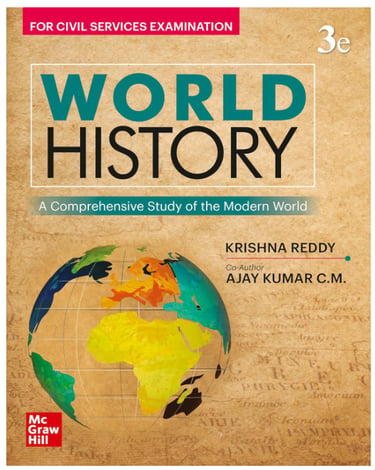The Cold War: The struggle for dominance between two Great Powers
In this article we shall study in-depth the various aspects related to Cold War. How the world was divided into two confronting blocks - Capitalist and Socialist and the ensuing confrontations between them.
WORLD HISTORY
The Cold War (1947-1991) was a geopolitical struggle between two superpowers—the United States of America and the Soviet Union and their respective allies. The conflict, though never escalating into a direct military confrontation between the two, shaped much of global history during the second half of the 20th century. It was a war of ideologies: 'Capitalism', led by the U.S., and 'Communism', led by the USSR. The Cold War affected politics, economics, culture, military policies, and diplomatic relations worldwide.
Origins of the Cold War
The roots of the Cold War can be traced back to the end of World War II. Despite being allies against the Axis powers during the war, the U.S. and the USSR had fundamental ideological differences. The U.S. championed a 'liberal democratic model' with capitalist economics, while the USSR promoted a 'Marxist-Leninist system' based on state-controlled socialism and a one-party government.
Several factors contributed to the start of the Cold War:
1. Yalta and Potsdam Conferences (1945):
Allied leaders met to decide the fate of post-war Europe. The agreements were often vague, particularly about the future of Eastern Europe. The Soviets established control over Eastern European nations, installing communist governments, which angered the U.S. and Britain.
2. Iron Curtain:
In 1946, Winston Churchill, in his famous speech, declared that an "Iron Curtain" had descended across Europe, symbolizing the division between the capitalist West and the communist East.
3. U.S. Containment Policy:
The U.S. adopted the 'Truman Doctrine' (1947), promising support to nations threatened by communism. This policy of containment aimed to prevent the spread of communism beyond Eastern Europe.
4. Marshall Plan (1948):
The U.S. launched the Marshall Plan, a massive economic aid program to help rebuild Western European economies devastated by World War II. The goal was to strengthen these nations to resist communist influence. The USSR saw this as a direct threat and refused the aid for itself and its allies.
Major Phases of the Cold War
1. Initial Phase (1947–1953):
During this period, tensions escalated as the U.S. and the USSR built their alliances. The NATO (North Atlantic Treaty Organization) was formed in 1949 as a collective defense alliance of Western countries, while the Soviets established the Warsaw Pact (1955) in response.
The 'Berlin Blockade (1948-1949)' and the subsequent airlift marked one of the first significant confrontations. Stalin blocked access to West Berlin, but the U.S. airlifted supplies to the city, thwarting Soviet aims.
2. Korean War (1950–1953):
The Cold War turned hot in the Korean Peninsula, where communist North Korea (supported by China and the USSR) invaded capitalist South Korea (backed by the U.S. and the UN). The war ended in a stalemate, but it was a significant moment in the Cold War, demonstrating the U.S.'s commitment to its containment strategy.
3. Khrushchev and the Thaw (1953–1962):
After Stalin’s death in 1953, Soviet Premier Nikita Khrushchev sought to reduce tensions in a period known as the 'Khrushchev Thaw'. However, events like the Hungarian Uprising (1956), where the USSR brutally suppressed a revolt, and the Berlin Crisis (1961), which culminated in the construction of the Berlin Wall, kept tensions high.
The most dangerous moment of the Cold War came during the Cuban Missile Crisis (1962), when the U.S. discovered Soviet nuclear missiles in Cuba. This brought the two superpowers to the brink of nuclear war, but diplomatic negotiations ultimately defused the crisis.
4. Vietnam War (1955–1975):
The Vietnam War became another proxy battlefield in the Cold War. The U.S. supported South Vietnam in its fight against the communist North, which was backed by the USSR and China. The war became deeply unpopular in the U.S. and ended with a communist victory, showing the limits of American interventionism.
5. Détente (1967–1979):
Détente was a period of reduced tensions between the U.S. and the USSR, marked by several arms control agreements, including the Strategic Arms Limitation Talks (SALT I) in 1972. Both superpowers recognized the destructive potential of nuclear war and sought to manage their rivalry through diplomacy.
However, the period of détente ended with the Soviet invasion of Afghanistan in 1979, which reignited Cold War tensions.
6. Final Phase (1980–1991):
Under U.S. President Ronald Reagan, the Cold War entered a new phase of confrontation. Reagan referred to the USSR as the "evil empire" and initiated a massive arms buildup. However, by the mid-1980s, the Soviet Union, under Mikhail Gorbachev, sought reforms through Glasnost (openness) and Perestroika (restructuring) to revive its stagnant economy.
Gorbachev's reforms, combined with rising nationalist movements within the USSR and Eastern Europe, led to the collapse of communist regimes in Eastern Europe (1989) and the eventual dissolution of the Soviet Union in 1991. This marked the definitive end of the Cold War.
Cold War Impacts on Global Politics
1. Nuclear Arms Race:
Both the U.S. and the USSR engaged in an intense arms race, leading to the development of thousands of nuclear weapons. This resulted in the doctrine of Mutually Assured Destruction (MAD), which acted as a deterrent to direct conflict but created a constant fear of nuclear annihilation.
2. Space Race:
The Cold War also extended into space. The launch of the Soviet satellite Sputnik in 1957 marked the start of the Space Race, with the U.S. and the USSR competing to achieve milestones in space exploration. The U.S. landing on the moon in 1969 was a major Cold War victory for the West.
3. Proxy Wars:
The Cold War saw numerous proxy wars across the globe, where the U.S. and the USSR supported opposing factions in civil conflicts, particularly in Africa, Latin America, and Asia. Examples include conflicts in Angola, Nicaragua, and Ethiopia.
4. Non-Aligned Movement (NAM):
Several nations, particularly in the developing world, sought to avoid alignment with either superpower, giving rise to the Non-Aligned Movement. Countries like India, under leaders such as Jawaharlal Nehru, played a significant role in advocating for a third path during the Cold War.
End of the Cold War
The Cold War ended primarily due to the internal problems of the Soviet Union, including economic stagnation, political unrest, and growing dissent in Eastern Europe. Gorbachev’s reforms allowed Eastern European nations to break free from Soviet control, and by 1991, the Soviet Union itself dissolved into 15 independent republics. The U.S. emerged as the world's sole superpower, marking the beginning of a new unipolar world order.
Lessons from the Cold War for Modern Geopolitics
1. Ideological Conflicts:
The Cold War highlighted the intensity of ideological battles, which continue in some forms today, especially in terms of authoritarianism versus democracy.
2. Importance of Diplomacy:
Diplomacy played a key role in averting several potential disasters during the Cold War, such as the Cuban Missile Crisis. Modern global challenges still require diplomatic engagement and multilateralism.
3. Nuclear Deterrence:
The arms race underscored the dangers of nuclear proliferation, and efforts to control nuclear weapons, such as the Nuclear Non-Proliferation Treaty (NPT), remain vital.
Conclusion
The Cold War was one of the most significant geopolitical events of the 20th century, shaping international relations for decades. Its legacy continues to influence global politics, economics, and military strategies today. For UPSC aspirants, understanding the Cold War provides valuable insights into the evolution of contemporary international systems, diplomacy, and the importance of strategic alliances in global power dynamics.


